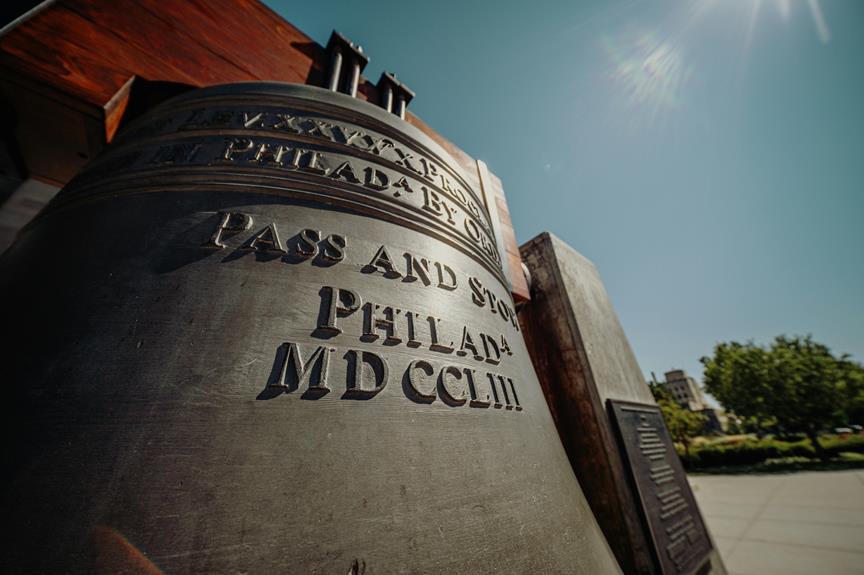The Holocaust Memorial in Berlin, Germany, stands as a somber reminder of one of the darkest chapters in human history. Its stark design and labyrinthine layout invite visitors to immerse themselves in contemplation. The memorial's significance reaches far beyond its physical presence, prompting profound questions about memory, responsibility, and the enduring legacy of the Holocaust. As we consider the complexities of remembrance and the weight of history, the Holocaust Memorial challenges us to confront uncomfortable truths and reflect on the lessons it holds for present and future generations.
Key Takeaways
- Inaugurated in 2005 to honor 6 million Jewish Holocaust victims.
- Features 2,711 concrete slabs symbolizing the victims.
- Promotes awareness, understanding, and vigilance against discrimination and genocide.
- Reflective pathways evoke disorientation for visitors.
- Urban integration creates a somber atmosphere for contemplation.
History of the Holocaust Memorial
The history of the Holocaust Memorial in Berlin, Germany, is a somber reminder of the atrocities committed during World War II. The origins of the memorial date back to 1988 when a group of citizens and survivors of the Holocaust initiated the idea. After a prolonged process, the memorial was officially inaugurated on May 10, 2005, marking a significant milestone in Germany's acknowledgment of its dark past.
The memorial holds immense educational value, serving as a poignant symbol of remembrance and reflection. It consists of 2,711 concrete slabs of varying heights arranged in a grid pattern over 4.7 acres. Visitors are encouraged to walk through the uneven pathways, evoking a sense of disorientation and unease that mirrors the experiences of the Holocaust victims. The design aims to provoke contemplation and dialogue about the consequences of intolerance and hatred.
Over the years, the memorial has become a central point for commemorating the six million Jewish victims of the Holocaust, as well as other marginalized groups targeted by the Nazi regime. It stands as a confirmation to the importance of preserving historical memory and fostering a collective commitment to ensuring such atrocities are never repeated. The Holocaust Memorial in Berlin continues to be a crucial site for promoting awareness, understanding, and vigilance against discrimination and genocide.
Design and Architecture
Characterized by its striking geometric arrangement and solemn ambiance, the design and architecture of the Holocaust Memorial in Berlin, Germany, captivate visitors with its powerful symbolism and thought-provoking layout. The modern aesthetics and urban integration of this memorial site stand out as remarkable features that contribute to its significance and impact.
The Memorial's Grid Structure: The memorial's design features a grid of 2,711 concrete slabs of varying heights arranged on undulating ground. This grid structure creates a sense of disorientation and contemplation for visitors as they navigate through the memorial.
Reflective Surfaces: The polished surfaces of the concrete slabs reflect light in different ways throughout the day, enhancing the visual experience and evoking emotions of remembrance and introspection.
Urban Integration: Situated in the heart of Berlin, the memorial seamlessly integrates into the urban landscape while creating a distinct and somber atmosphere. Its location amidst the bustling city serves as a poignant reminder of the atrocities of the past, fostering dialogue and reflection on historical events.
The design and architecture of the Holocaust Memorial in Berlin not only pay homage to the victims of the Holocaust but also serve as a powerful symbol of remembrance and education for future generations.
Symbolism and Meaning
With its intricate symbolism deeply embedded in its design, the Holocaust Memorial in Berlin, Germany, conveys profound meanings that resonate with visitors on a reflective and emotional level. The memorial, consisting of 2,711 concrete slabs of varying heights arranged in a grid pattern over 19,000 square meters, symbolizes the enormity of the Holocaust and the systematic extermination of six million Jewish people. The stark, grey pillars evoke a sense of disorientation and unease, reflecting the chaos and despair of that dark period in history.
Each visitor's experience within the memorial is unique, as they navigate through the uneven pathways created by the slabs, representing the unpredictability and harsh realities faced by the victims. The memorial's design encourages visitors to contemplate the past and consider the consequences of intolerance and hatred, serving as a powerful reminder of the atrocities committed during the Holocaust.
Moreover, the memorial's location in the heart of Berlin, near the Brandenburg Gate and other significant historical sites, underscores Germany's commitment to acknowledging its dark past and promoting remembrance. By engaging with the symbolism embedded in the memorial, visitors are encouraged to reflect on the importance of preserving the memory of the Holocaust and actively working towards a future free from discrimination and violence.
Visitor Experience and Reflection
Immersing oneself in the Holocaust Memorial in Berlin prompts visitors to engage with history on a deeply personal and introspective level. The experience is designed to evoke a range of personal emotions and encourage reflection through various interactive elements.
- Reflective Pathways: The memorial's grid of concrete slabs, known as stelae, creates a maze-like atmosphere that encourages visitors to wander through the uneven pathways. This design symbolizes the confusion and disorientation experienced during the Holocaust, prompting visitors to reflect on the individual stories of loss and suffering.
- Interactive Learning Centers: Within the memorial, there are information centers that provide historical context, personal stories, and interactive exhibits. These centers offer visitors a deeper understanding of the events surrounding the Holocaust and allow for a more immersive learning experience.
- Silent Contemplation Areas: Scattered throughout the memorial are secluded spaces that offer visitors a moment of solitude for personal reflection. These areas provide a peaceful setting for individuals to process their emotions and thoughts in response to the memorial's somber atmosphere.
Controversies and Criticisms
The Holocaust Memorial in Berlin has faced various controversies and criticisms that shed light on differing perspectives regarding its design and purpose. One of the main points of contention revolves around the ethical implications of the memorial's abstract nature. Critics argue that the vast field of concrete slabs fails to convey the individual experiences of the Holocaust victims, potentially diluting the emotional impact that a more personalized memorial might have achieved. This perspective raises questions about the balance between creating a solemn commemoration and ensuring that the victims are not reduced to mere numbers in a historical narrative.
Furthermore, public perception of the memorial has been divided. While some praise its stark and imposing appearance as a fitting tribute to the magnitude of the Holocaust, others find it cold and impersonal. The minimalist design has been criticized for lacking explicit symbols or inscriptions that could help visitors contextualize the memorial's significance. This ambiguity has led to debates about the effectiveness of the memorial in conveying its intended message to a diverse audience.
Importance of Remembering
Remembrance serves as a critical pillar in preserving the collective memory of historical atrocities and honoring the victims' enduring legacies. It is through the act of remembering that societies can learn from past mistakes, guarantee that such atrocities are never repeated, and pay tribute to those who suffered.
The importance of remembering the Holocaust Memorial in Berlin, Germany, extends far beyond the physical structure itself. Here are three key reasons why the act of remembrance holds such paramount significance:
- Memory Preservation: By actively remembering the Holocaust and the millions of lives lost, we are safeguarding the memory of those who perished and ensuring that their stories are not forgotten. This act of remembrance helps to keep history alive and relevant for future generations.
- Educational Significance: The Holocaust Memorial serves as a powerful educational tool, allowing visitors to learn about the atrocities committed during one of the darkest periods in human history. Through education and reflection, individuals can gain a deeper understanding of the consequences of hatred, discrimination, and indifference.
- Honoring Victims' Legacies: Remembering the Holocaust is a way to honor the enduring legacies of the victims and survivors. It is a solemn reminder of the resilience and strength displayed in the face of unimaginable adversity, guaranteeing that their stories live on for generations to come.
Frequently Asked Questions
How Many Names Are Inscribed at the Holocaust Memorial?
The number of victims inscribed at the Holocaust Memorial is not explicitly stated in the question. However, the Memorial design features 2,711 concrete slabs of varying heights set on a sloping field, evoking a sense of disorientation and remembrance.
The overall effect is a haunting and contemplative space that honors the millions who perished during the Holocaust.
Are There Any Specific Rules for Visitor Behavior at the Memorial?
In places of commemoration, visitor etiquette plays a pivotal role in maintaining a respectful environment. Respectful behavior at memorials often includes guidelines such as speaking in hushed tones, refraining from disruptive activities, and avoiding any behavior that may detract from the solemnity of the site.
These rules are in place to guarantee that all visitors can pay their respects in an atmosphere of dignity and reflection.
Do Survivors of the Holocaust Have a Special Role at the Memorial?
Survivors of the Holocaust hold a vital and significant role at memorials worldwide due to their firsthand experiences of one of history's darkest chapters. Their presence adds a deeply personal and poignant layer to these sites, serving as a reminder of the atrocities committed and the resilience of the human spirit.
As eyewitnesses to the horrors of the Holocaust, survivors play an essential role in ensuring that the historical significance of these events is preserved for future generations.
Is Photography Allowed at the Holocaust Memorial?
Photography rules at memorials often dictate whether photography is allowed, aiming to maintain respect and dignity for the space and its significance.
Memorial etiquette typically discourages photography inside sensitive areas to make sure visitors engage thoughtfully with the content.
Understanding and adhering to these guidelines is essential for visitors to honor the purpose of the memorial and show respect for the historical events it commemorates.
Are There Any Annual Events or Ceremonies Held at the Memorial?
Public commemorations and annual ceremonies are held at this significant site, providing a space for reflection and remembrance.
These events serve as a poignant reminder of the atrocities of the past and the importance of learning from history.
The solemnity of these gatherings underscores the necessity of honoring the memory of those who perished and ensuring that their stories are never forgotten.
Conclusion
To sum up, the Holocaust Memorial in Berlin stands as a powerful tribute to the 6 million Jewish victims of the Holocaust. Through its unique design and symbolism, the memorial serves as a reminder of the consequences of intolerance and discrimination.
It encourages visitors to reflect on the importance of remembrance and vigilance against all forms of genocide. The memorial's significance lies in its ability to educate, inspire empathy, and promote a commitment to combating hatred and injustice.


